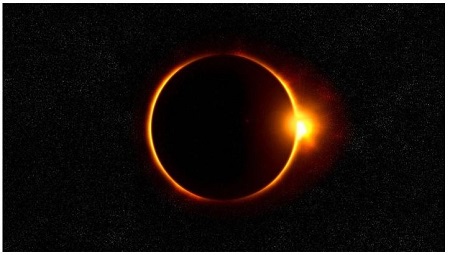Total solar eclipse on April 8: Toronto will see the next one in 2144
TORONTO – It’s eclipse day in Toronto, tomorrow. A total solar eclipse, an event which was last observed in Toronto in 1925 and which will only be seen again in 2144. “An unrepeatable event” (for those living now…), Robert Cockcroft, professor of astronomy and physics at McMaster University, said on Thursday to CTV. A very rare event because it occurs “when you get the perfect alignment between the Moon and the Sun, and it’s just a coincidence that they appear on the same side of the sky. Also, the Sun is about 400 times larger than the Moon, but it’s also 400 times farther from Earth, so they appear exactly the same size” only at that exact moment.
In reality a total solar eclipse is not, in itself, a particularly rare event: it happens once every eighteen months or so in various parts of the world, so “if you are willing to travel to an eclipse – said Cockcroft – it is not such a rare event. You may see one every one to two years. The fact that the eclipse ‘comes to you’ is what makes it rare. This is what makes it something unrepeatable”, in the span of a lifetime.
For it to be repeatable, therefore, you have to travel. And there are those who do it, like Paul Delaney, astronomer and professor at York University, who has “chased” eclipses, until seeing three total solar eclipses. The second was in 1979 in Brandon, Manitoba. “It was February and it was chilly on the roof of Brandon University, but the skies were clear. My master’s thesis was based on my observation of the sun that day” Delaney told CTV.
Tomorrow’s eclipse will take place starting around 2pm (2pm), experts say, and the entire “operation” will last about two and a half hours. But “the thing that everyone is looking forward to is that 90 seconds in the middle, when the eclipse is total” Cockcroft said.
Click here to see path of totality and partial contours crossing the U.S. for the 2024 total solar eclipse occurring on April 8, 2024 (by NASA)
The complete blocking of the Sun by the Moon, which will be visible in Toronto – approximately – around 3.20pm (3.20pm), will cause darkness for a short period of time. And, depending on the conditions and how clear the sky is at the time of the eclipse, the first thing that will be noticed during the eclipse will be the solar corona, a white haze around the sun.
But, in fact, the sky will have to be clear to be able to see it well… “the snowstorms that you had earlier this past week in Toronto, if that had been forecast on Monday, I would have been terribly disappointed” said Delaney. “At the moment the forecast is iffy and so I’m quietly optimistic. But you have to take it with a grain of salt. Whenever you chase eclipses, solar or lunar. You’ve got to be prepared for failure from the weather“.
Attention to your eyes: use filters to protect them
When the Moon completely blocks the bright face of the Sun, it is not safe to look directly at the Sun without specialized eye protection for solar observing. In fact, as NASA explains on its website, “Viewing any part of the bright Sun through a camera lens, binoculars, or a telescope without a special-purpose solar filter secured over the front of the optics will instantly cause severe eye injury. When watching the partial phases of the solar eclipse directly with your eyes, which happens before and after totality, you must look through safe solar viewing glasses (‘eclipse glasses’) or a safe handheld solar viewer at all times. Eclipse glasses are NOT regular sunglasses; regular sunglasses, no matter how dark, are not safe for viewing the Sun. Safe solar viewers are thousands of times darker and ought to comply with the ISO 12312-2 international standard. Maximum caution, therefore: you need glasses specially made for solar observation and, even if you use devices such as mobile phones, cameras, binoculars or telescopes, you must use a special solar filter to protect your eyes”.
TO read the whole “safety tips” by Nasa, click here. All the most reliable information on today’s total eclipse is available on the NASA website at https://science.nasa.gov
A very special soundtrack to maximize the experience
To maximize the musical and emotional impact of the moment, you should listen to the entirety of The Dark Side of the Moon by Pink Floyd as part of your 2024 solar eclipse experience. According to Ultimate Classic Rock & Culture (https://ultimateclassicrock.com/), “to do so on Spotify, you’ll need to start the album 41 minutes and 53 seconds before the start of the total eclipse in your location. If you’re listening on CD, vinyl or another streaming service, there may be slight variations in the running time, so be sure to check ahead. You also might want to make sure in advance that you won’t be interrupted by any ads. For example, at UCR headquarters in Akron, the total eclipse is scheduled to start at 3:14:14 p.m. EDT. So we’ll be starting The Dark Side of the Moon at 2:32:21 p.m. EDT. If you’re pressed for time, you can simply start the album’s closing song, ‘Eclipse’, 70 seconds before your local total eclipse start time”. In both cases, the album’s fateful closing line (“…and everything under the sun is in tune, but the sun is eclipsed by the moon”) will arrive just as the eclipse is total. In short: enjoy watching and… enjoy listening!



